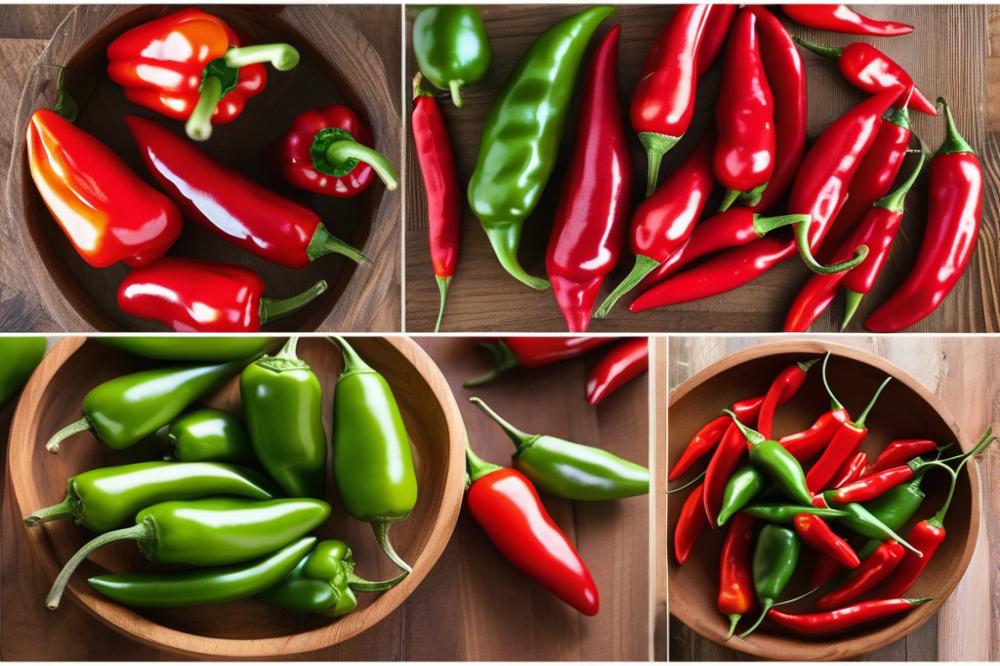Understanding Pequin Peppers
Pequin Peppers are small, fiery chilies that pack a significant punch. These spicy peppers originate from Mexico but are now popular in various cuisines around the world. They are often used to enhance dishes with their distinctive heat and flavor. Famed for their vibrant red or orange color, these tiny gems add a burst of color as well as taste to meals.
Cooking with Pequin peppers can elevate a simple dish. Chefs appreciate their intense heat, which does not overpower other flavors but rather complements them. Many people love adding crushed Pequin peppers to salsas, soups, and sauces for an extra kick. They can also be included in marinades or as a seasoning for meats and vegetables, making them versatile in the kitchen.
Proper Cultivation Techniques are vital for growing Pequin peppers successfully. These little peppers thrive in warm climates but also require specific conditions to flourish. Gardeners must pay attention to soil requirements, as well as water needs, to support healthy plant growth. Mastering pepper care involves selecting the right planting strategies and understanding growth cycles. Whether you are a beginner or an experienced gardener, employing effective gardening techniques will help you enjoy a bountiful harvest of these flavorful peppers. By following the right methods, anyone can add these unique peppers to their gardening repertoire.
Understanding Pequin Peppers


Pequin peppers are small, cherry-shaped fruits that belong to the Capsicum annuum species. They are typically about 1 to 2 inches long and grow upright on the plant. The color varies from green to bright red when ripe. Owing to their compact size, these peppers are easy to grow in small spaces or containers, making them popular among home gardeners.
Flavor Profile and Heat Level
A distinctive characteristic of Pequin peppers is their intense heat, which ranges between 30,000 to 60,000 Scoville Heat Units. Most people find them to be significantly spicier compared to jalapeños. The flavor has a smoky, nutty quality that adds depth to various dishes. This pepper works well in salsas, sauces, and even as a spice in stews. Because of their concentrated heat, a little goes a long way in recipes.
Ideal Growing Conditions
When considering planting Pequin peppers, it is essential to think about the growing conditions. These plants thrive in warm climates with plenty of sunshine. Ideally, temperature ranges between 70°F and 85°F are perfect for growth. Soil requirements include well-draining, nutrient-rich soil with a pH between 6.0 to 7.5. Adding compost can greatly benefit the plant’s development.
Water needs are also important. Regular watering helps maintain consistent moisture levels but avoid waterlogging. A drip irrigation system can be an excellent option to provide steady moisture. For those interested in gardening techniques, mulching can reduce water evaporation and keep the soil temperature consistent.
Before harvesting Pequin peppers, wait until they become bright red for maximum flavor and heat. Usually, this happens around 90 days after planting. Following these tips will contribute to successful pepper care and a rewarding gardening experience.
Planting Pequin Peppers


Best Time to Plant Pequin Peppers
The ideal season for growing Pequin peppers is in the spring. Once the danger of frost has passed, soil temperatures should be consistently above 70°F. This environment promotes healthy growth. Starting seeds indoors about eight weeks before the last frost date is recommended. Transplanting seedlings outdoors gives them a strong start. Wait until nighttime temperatures remain above 50°F for optimal conditions.
Soil Requirements for Optimal Growth
Soil quality plays a critical role in the health of your plants. Well-draining soil is essential for preventing root rot. A mix of loamy soil enriched with organic material works best. Aim for a pH level around 6.0 to 6.8. Regular testing can help maintain these levels. Good drainage can be improved with sand or perlite if necessary. Nutrient-rich soil will enhance growth and yield during the harvest.
Techniques for Starting Seeds Indoors or Direct Sowing
Starting seeds indoors allows for earlier growth and better control over conditions. Use seed trays filled with seed-starting mix. Keep the trays in a warm spot with plenty of light. Once seedlings emerge, thin them out to prevent overcrowding. If you prefer direct sowing, plant seeds in well-prepared soil after the last frost. Spacing seeds about 18 inches apart is advisable. Water consistently to maintain moisture but avoid oversaturation.
Choosing the Right Pepper Varieties
Selecting the right variant can greatly influence your success. Several unique pepper varieties exist, each offering different heat levels and flavors. Popular options include ‘Aji Crystal’ and ‘Poblano’ for those who enjoy spicy peppers. Adapt your choice to your taste and region for better results. Local garden centers often carry a selection tailored to your area. Consider your cooking preferences when making a decision on varieties. This will maximize your enjoyment of harvesting Pequin peppers later on.
Pepper Care for Pequin Peppers


Water Needs and Irrigation Techniques
Growing Pequin peppers requires careful attention to water needs. These spicy peppers thrive in consistently moist soil but should never sit in water. Drip irrigation systems are an effective option. They deliver water directly to the roots, minimizing waste. Monitoring soil moisture is vital. A simple test involves sticking a finger into the earth. If it feels dry, it’s time to water. During particularly hot days, plants may need more frequent watering. Keep an eye on weather patterns to adjust your schedule accordingly.
Fertilization Tips for Healthy Growth
Fertilizing is important for healthy growth when planting Pequin peppers. A balanced fertilizer, such as one with equal parts nitrogen, phosphorus, and potassium, supports robust development. Start by applying fertilizer a few weeks after planting. Repeat this every four to six weeks throughout the growing season. Some gardeners prefer organic options like compost or aged manure. These enrich the soil and benefit overall plant health. Always follow recommended application rates to avoid nutrient burn.
Pest and Disease Management Strategies
Managing pests and diseases is crucial in maintaining healthy pepper plants. Common pests include aphids and spider mites. Regular inspections can help catch infestations early. If pests are spotted, consider using insecticidal soap or neem oil. Rotating crops each year also helps reduce disease risk. Always look for resistant varieties if they are available. Proper air circulation between plants can deter fungal diseases. Remove any infected leaves promptly to protect the rest of your garden.
Supporting Plants for Better Yield
Providing proper support for taller pepper varieties can improve yield. Staking or using cages helps stabilize plants as they grow. This prevents branches from breaking under the weight of the peppers. Additionally, good support encourages airflow around the plants. Healthier plants are often more productive, yielding larger harvests. Clear away weeds regularly too, as they compete for nutrients and water. Establishing a solid foundation with good practices is key for maximizing your harvest.
Garden Tips for Growing Pequin Peppers


Companion Planting and Garden Layout
Companion planting can help improve your pepper care. Consider growing basil, marigold, or onions nearby. These plants can repel harmful insects that may damage your spicy peppers. Choose a layout that allows for good air circulation. Proper spacing between plants can prevent diseases and encourages healthy growth. Keep in mind that peppers thrive in a well-compacted garden. By grouping similar plants together, you can create an efficient and productive garden space.
How to Maximize Sunlight Exposure
Pequin peppers love sunlight. Aim for at least 6 to 8 hours of direct sun each day. If you are planting in a small garden, place taller plants on the north side. This helps avoid shade on shorter plants. Observe the sun’s path before planting to determine the best spots. When arranging your garden, make adjustments throughout the growing season. Moving potted plants can enhance light exposure and contribute to healthier growth.
Mulching and Weed Control Techniques
Mulching is an effective technique for maintaining moisture in your soil. Use straw, wood chips, or grass clippings around your plants. This can keep the soil temperature stable and reduce the need for frequent watering. Protecting your peppers also requires controlling weeds. Hand-pulling is effective but can be labor-intensive. Consider using landscape fabric to suppress weed growth. Remember that healthy, well-maintained soil contributes to vibrant plants. Regularly check for any signs of weeds or other threats as you care for your peppers.
Harvesting Pequin Peppers
Signs of Ripeness in Pequin Peppers
Identifying when to pick these spicy peppers is crucial. Pequin peppers typically change from green to a vibrant red or orange when they are ripe. A glossy appearance is another indicator of maturity. The fruit should feel firm to the touch, not soft or wrinkled. Gardeners often prefer harvesting when the peppers have reached their full color, as this is when their flavor and heat are at their peak. Additionally, look for a slight shine on the skin. This sheen suggests that the peppers are ready to be harvested.
Best Methods for Harvesting
Using the right technique can make harvesting easier. Snipping the peppers off with scissors or garden shears helps prevent damage to the plant. Grabbing the peppers by hand may lead to breaking stems, so caution is essential. Wear gloves to avoid skin irritation, as some varieties can be quite spicy. Picking in the morning, after dew has dried, often yields the best results. This timing helps preserve the freshness and quality of the peppers.
Post-Harvest Handling and Storage
What comes after harvesting is just as important. Properly handling Pequin peppers maintains their flavor and texture. Place freshly harvested peppers in a breathable container to avoid moisture build-up. Storing them in a cool, dry place prolongs their shelf life. Refrigeration can also be beneficial if you plan to store them for longer periods. However, keep in mind that they may lose some of their crunchiness in the fridge. For longer-lasting storage, consider drying or freezing. Each method helps in showcasing the unique flavors of these peppers over time. Following these garden tips can enhance your pepper care and storage techniques.
Final Thoughts on Cultivating Pequin Peppers
In summary, the best practices for cultivating Pequin peppers involve a combination of proper soil selection, adequate watering, and attentive pest management. Choosing well-drained, nutrient-rich soil sets the foundation for robust growth. Regular watering helps to maintain healthy plants, but overwatering can lead to problems. Monitoring for pests and implementing organic control methods are crucial for protecting your crop. Each step plays an essential role in the overall success of your gardening experience.
For those who enjoy gardening, trying your hand at growing Pequin peppers can be an exciting adventure. Experimentation often leads to discovering new techniques that suit your specific environment. Whether you are a novice or have some experience, each plant offers a chance to learn something new. Don’t hesitate to adjust your methods based on what works best for you.
Ultimately, there is a great deal of satisfaction that comes from nurturing spicy pepper plants from seedlings to harvest. Watching them flourish under your care brings joy and accomplishment. Pequin peppers not only add flavor to dishes but also allow for creativity in cooking. Embrace the journey of cultivating these unique peppers and enjoy every moment along the way. Happy gardening!



